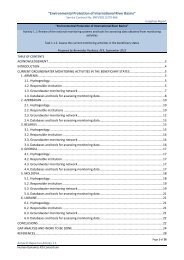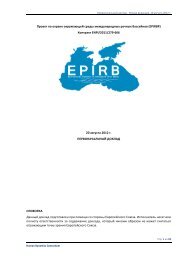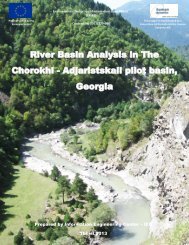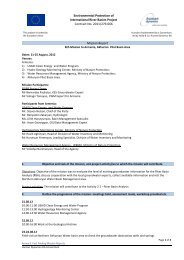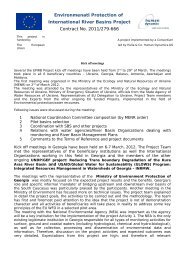Nokia Standard Document Template - Environmental Protection of ...
Nokia Standard Document Template - Environmental Protection of ...
Nokia Standard Document Template - Environmental Protection of ...
- No tags were found...
You also want an ePaper? Increase the reach of your titles
YUMPU automatically turns print PDFs into web optimized ePapers that Google loves.
4th Mission Report _KE3_Jan –Feb 2013When the Time Drive method is set up, one can preset the emission, and excitation wavelengths togetherwith the duration <strong>of</strong> each integration period (set at 5 seconds). The duration <strong>of</strong> the scan could also be sete.g. 100 seconds. One could also set up the file name (td file) so that the graphical results could be saved.The instrument uses a simple traffic light icon to be clicked to start the analysis, which then initiated the100 second scan showing the fluorescence emission value graphically.iii) Using the above technique, this method was tested by using a range <strong>of</strong> crude oil standardsconcentrations from 0.5 to 10µg/l in hexane, which produced emissions from 200 to about 996, with ablank <strong>of</strong> about 27. This indicated that the LOD for this method could, in theory, reach at least 0.05µg/l,though would depend on the liquid/liquid extraction, and concentration efficiencies.iv) The KE3 recommended that this method should be developed for specific hydro carbons such as crudeoil, diesel oils & total petroleum products where standard methods are available by:a. Initially making up at least 6 concentration standards in the extraction solvent (hexane) to producea calibration graph to determine the linearity range.b. Following this, carry out the ISO extraction procedure on a similar series <strong>of</strong> standards made up indistilled water in order to determine the ideal recoveries.c. Repeat (b) using standards in the Pilot River water <strong>of</strong> the Chorokhi – Adjaristkali taken from a goodreference site (site with no anthropogenic activity so that the water should be pure as possible) toestablish the extraction efficiencies from the river water.d. It was also recommended to repeat this process from similar pure water from the Black Sea, whichwould be important for the department in analyzing the sea and also for the imminent new EUsister project investigating the coastal regions.If the Department does not have the available time to undertake this method development, it could be anideal project for a research M.Sc. postgraduate study, which would also minimise costs.v) The FS 45 does have other useful facilities, such as scanning fluorescence at differing wavelengths,which could be useful for determining new methods for compounds where there are no ISO methodsavailable. When this is required, the KE3 expert could investigate this new operational procedure duringfuture missions to further develop the application <strong>of</strong> this equipment.3) Other Equipment ProblemsThe KE3 also checked the inoperative microwave digester, unfortunately there was insufficient time t<strong>of</strong>ully investigate this problem and it was recommended that this is progressed in the next appropriatemission as this apparatus is not as vital as the others.The Laboratory also had a Scalar Continuous Bubble Flow Analyser dedicated for measuring nitrates,phosphates and ammonia. This had recently broken down and appeared to have a power problem andwas due to be fixed soon.The Chemical Laboratory had so many problems with their expensive sensitive equipment, could becaused by poor electrical supplies. It was recommended that, where possible, to using anti surge electricalsockets, and power regulators to avoid electrical spikes, and safeguard the equipment, though this mightnot be possible for the AAS.4) Analytical Quality ControlPage 15 <strong>of</strong> 36




